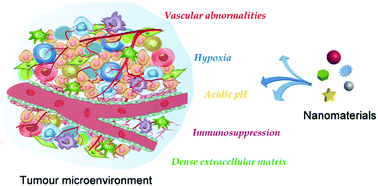当前位置:
X-MOL 学术
›
Chem. Soc. Rev.
›
论文详情
Our official English website, www.x-mol.net, welcomes your
feedback! (Note: you will need to create a separate account there.)
Nanoparticle design strategies for enhanced anticancer therapy by exploiting the tumour microenvironment
Chemical Society Reviews ( IF 40.4 ) Pub Date : 2017-05-18 00:00:00 , DOI: 10.1039/c6cs00592f Yunlu Dai 1 , Can Xu 2 , Xiaolian Sun 3 , Xiaoyuan Chen 2
Chemical Society Reviews ( IF 40.4 ) Pub Date : 2017-05-18 00:00:00 , DOI: 10.1039/c6cs00592f Yunlu Dai 1 , Can Xu 2 , Xiaolian Sun 3 , Xiaoyuan Chen 2
Affiliation

|
Nanovehicles can efficiently carry and deliver anticancer agents to tumour sites. Compared with normal tissue, the tumour microenvironment has some unique properties, such as vascular abnormalities, hypoxia and acidic pH. There are many types of cells, including tumour cells, macrophages, immune and fibroblast cells, fed by defective blood vessels in the solid tumour. Exploiting the tumour microenvironment can benefit the design of nanoparticles for enhanced therapeutic effectiveness. In this review article, we summarized the recent progress in various nanoformulations for cancer therapy, with a special emphasis on tumour microenvironment stimuli-responsive ones. Numerous tumour microenvironment modulation strategies with promising cancer therapeutic efficacy have also been highlighted. Future challenges and opportunities of design consideration are also discussed in detail. We believe that these tumour microenvironment modulation strategies offer a good chance for the practical translation of nanoparticle formulas into clinic.
中文翻译:

利用肿瘤微环境增强抗癌治疗的纳米颗粒设计策略
纳米载体可以有效地将抗癌药物携带并输送到肿瘤部位。与正常组织相比,肿瘤微环境具有一些独特的性质,例如血管异常、缺氧和酸性pH。有许多类型的细胞,包括肿瘤细胞、巨噬细胞、免疫细胞和成纤维细胞,由实体瘤中有缺陷的血管提供营养。利用肿瘤微环境有利于纳米粒子的设计,以提高治疗效果。在这篇综述文章中,我们总结了各种癌症治疗纳米制剂的最新进展,特别强调了肿瘤微环境刺激响应纳米制剂。许多具有前景的癌症治疗功效的肿瘤微环境调节策略也得到了强调。还详细讨论了设计考虑的未来挑战和机遇。我们相信这些肿瘤微环境调节策略为纳米颗粒配方实际转化为临床提供了良好的机会。
更新日期:2017-05-31
中文翻译:

利用肿瘤微环境增强抗癌治疗的纳米颗粒设计策略
纳米载体可以有效地将抗癌药物携带并输送到肿瘤部位。与正常组织相比,肿瘤微环境具有一些独特的性质,例如血管异常、缺氧和酸性pH。有许多类型的细胞,包括肿瘤细胞、巨噬细胞、免疫细胞和成纤维细胞,由实体瘤中有缺陷的血管提供营养。利用肿瘤微环境有利于纳米粒子的设计,以提高治疗效果。在这篇综述文章中,我们总结了各种癌症治疗纳米制剂的最新进展,特别强调了肿瘤微环境刺激响应纳米制剂。许多具有前景的癌症治疗功效的肿瘤微环境调节策略也得到了强调。还详细讨论了设计考虑的未来挑战和机遇。我们相信这些肿瘤微环境调节策略为纳米颗粒配方实际转化为临床提供了良好的机会。











































 京公网安备 11010802027423号
京公网安备 11010802027423号